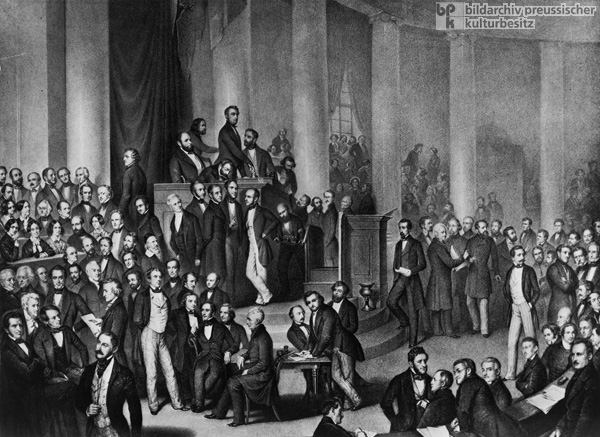













INTRODUCTION | DOCUMENTS | IMAGES | MAPS | EDITOR
|
Elected by all “independent” adult males, the Frankfurt National Assembly (also known as the German National Assembly or the Frankfurt Parliament) was the first all-German parliament. It convened for the first time on May 18, 1848, in Frankfurt am Main. The lithograph below shows the group during a session break. In addition to conveying the general atmosphere of the chamber, the illustration offers a glimpse into the activities of the parliamentarians, who are shown consulting with one another, studying draft bills, polishing notes, and engaging in discussion, both among themselves and with spectators – in this case, with some prominent women that the artist has conveniently seated in the (nearer) men’s gallery to the right of the podium, thereby allowing himself an opportunity to include their portraits here. Standing highest on the podium and wielding the president’s bell, the liberal Heinrich von Gagern (1799-1880) assumes priority within the tableau. As a trained jurist and former administrative official in Hesse, he was also typical of the parliament’s membership. Contrary to contemporary popular opinion, the parliament was not merely a debating club for professors. In fact, of the 812 members, only 124 were teachers and professors, whereas jurists in public-service professions (173 administrative officials, 110 judges and state attorneys) and members of the free professions (106 lawyers) were predominant. Peasants (3) and craftsmen (4), however, were clearly underrepresented; there were no delegates from the working classes or of the lower classes in general. Although discussion was regarded as a hallmark of democratic culture, contemporaries criticized the parliament for indulging in lengthy and garrulous but fruitless debates. In retrospect, however, these criticisms were to some extent dispelled by the Assembly’s accomplishments, namely, the establishment of a German government by June 1848 and the drafting and passing of the momentous Charter of Basic Rights by December of that year. Nonetheless, time worked against the parliamentary idea and the forces of counterrevolution regrouped, using their state power to roll back democratic advances. Lithograph by Eduard Meyer after a drawing by Paul Bürde (1819-1874), no date.
© Bildarchiv Preußischer Kulturbesitz |
 print version
print version return to image list
return to image list previous image
previous image
